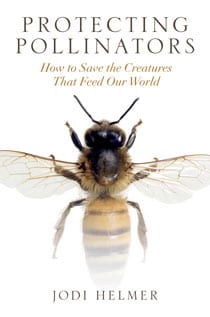Protecting Pollinators: How to Save the Creatures That Feed Our World

Written by Jodi Helmer
Published by Island Press, April 2019
Reviewed by Nanette Masi
Protecting Pollinators by Jodi Helmer is a must-read for anyone interested in learning more about the myriad small and amazing creatures so crucial to our survival as a species. Reading the book is like having a dear friend share with you all the fascinating things she’s learned about pollinators during her journey to becoming a successful beekeeper, then placing all her resources at your fingertips.
Helmer has truly done her homework. She intersperses a treasure-trove of organized research into her narrative through a series of related sidebar boxes that highlight articles of special interest. Boxed articles range from descriptions of the intricate role pollinators play in the natural world to the latest research regarding colony collapse disorder to the development of robot bees with gel-coated horsehair bristles to sustainable bat-friendly tequila and more. I was fascinated to learn that the Venus flytrap only snaps its jaws around non-pollinating beetles, ants, and crickets, while insects carrying the flytrap’s pollen get a free pass (p. 81).
In fact, I was only three pages into the book when I found the information so compelling, I began taking notes. Twenty pages in, I realized I needed a less time-consuming method. I began marking passages with mini post-its, until so many markers protruded from the pages that the book began to resemble a hedgehog. It was only after I ran out of post-its that I realized the book contained an added bonus – a 41-page detailed index and selected bibliography that allows easy access to the astonishing amount of information packed into 178 pages.
To me, a great book is one that inspires curiosity and further research. The more I learned from Helmer’s book, the more I wanted to know. Her list of endangered pollinators included eight bee species, mostly Hawaiian. I wondered if the rusty-patched bumblebee might be found in my area. A quick google search turned up a fascinating 20-minute online documentary about a nature photographer on a quest: “A Ghost in the Making; Searching for the Rusty-Patched Bumblebee” by Neil Losin and Clay Bolt (https://www.rustypatched.com). Who knew bees came in so many amazing colors? According to the film, the rusty-patched bumblebee was once plentiful in the northeast. Now I can celebrate the arrival of spring with a rusty-patched bumblebee search of my own.
Beyond the great depth of well-researched information, what I came to appreciate most about Helmer’s book was her positivity in the face of presenting hard truths regarding sweeping pollinator losses on a global scale. Sometimes the more you know, the more you feel like hiding your head in the sand. Helmer offers an antidote to feelings of overwhelming helplessness by providing example after example of innovative pollinator protection programs sparked by the efforts of committed individuals, communities, organizations, and businesses. Programs like Sponsor-a-Hive and the Butterfly Highway are enacting meaningful change and continuing to grow and spread.
As I turned the final page, my mind flooded with mixed emotions. While my heart sank with the full knowledge of the degree of harm inflicted upon pollinators, I also felt fully empowered and enthused to do something about it. I plan to begin my dedicated pollinator protection effort with a visit to my local library to help establish a “seed library” that allows library patrons to “borrow” seeds for plants that attract a range of pollinators. Although patrons aren’t expected to return the seeds, they’re welcome to collect and donate seeds back to the library to keep the program going and growing. (p. 52). Then I’ll make an appointment with my newly elected first female mayor to encourage the establishment of a Bee City USA program in Amesbury. Appearing in sixty-six cities in twenty-four states so far, this program offers an “open source” model that encourages communities to create public-private partnerships to raise awareness of the importance of pollinators and provide pollinator habitats (p. 52).
I encourage you, too, to spread the word and make a difference in the world while celebrating the holidays by sharing Protecting Pollinators as a gift. As individuals and collectively, we can each play an important role in protecting the fascinating and important little beings that ensure our basic food production and add beauty to our world.
About the Reviewer
Nanette Masi is a nature-inspired landscape designer, photographer, write, and educator. Her business, Back to Nature, creates sanctuary landscapes that soothe the soul and connect her clients to the natural world, integrating native and sustainable plant communities that bring beauty, bird song and butterflies into their lives. With degrees in Botany, Ecology and Education, and years of organic gardening and design experience, Nanette has been a guiding force in the creation of wildlife habitat gardens throughout the region. Nanette also brings seminars to life through her award-winning nature and landscape photography. She is a regular speaker for watershed groups, ecological landscaping organizations, schools and gardening clubs.
***
Each author appearing herein retains original copyright. Right to reproduce or disseminate all material herein, including to Columbia University Library’s CAUSEWAY Project, is otherwise reserved by ELA. Please contact ELA for permission to reprint.
Mention of products is not intended to constitute endorsement. Opinions expressed in this newsletter article do not necessarily represent those of ELA’s directors, staff, or members.

